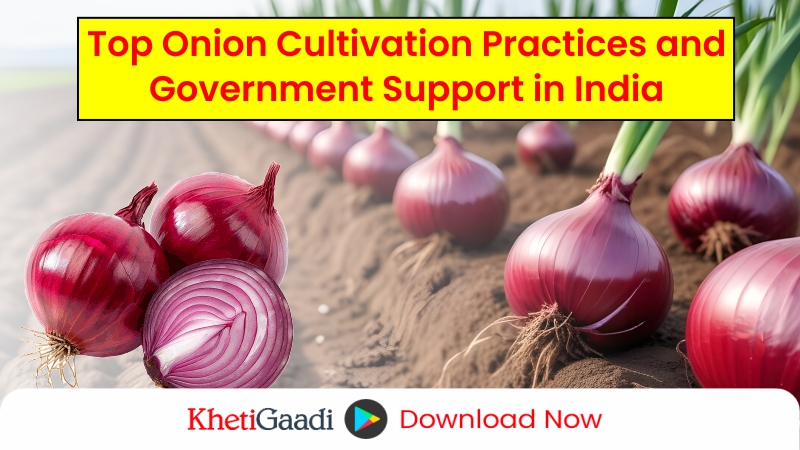Onion is one of the most widely consumed vegetables in India, finding its place in every kitchen and recipe. It is not just an essential ingredient but also a crucial crop for farmers, contributing significantly to their livelihood. As of 2023, India stands as the second-largest producer of onions globally, after China. However, despite such high production levels, onion prices tend to fluctuate, impacting both consumers and farmers alike. This blog will dive into the complete cycle of onion farming in India—from seed to harvest—while exploring market trends, government schemes, and real-life success stories.
Introduction
Onion farming is not just an agricultural practice in India; it’s a critical economic activity. From households to restaurants, onions are a vital food ingredient. Yet, onion farming is influenced by several factors such as weather, soil type, water availability, and market fluctuations. In this blog, we will discuss the entire process of onion farming and shed light on various government schemes that aim to support onion farmers in India.
Overview of Onion Prices and Market Trends
Onion prices in India are subject to sharp fluctuations. A bumper crop can bring down prices significantly, while adverse weather conditions or pest attacks can lead to shortfalls, resulting in price spikes.
Trends:
- Price Volatility: Prices in retail markets can vary dramatically based on seasonal availability. For instance, in 2023, prices peaked at around ₹80 per kg in some regions due to supply shortages caused by heavy rains.
- Government Intervention: To manage volatility, the government often imports onions from countries like Egypt and Turkey, imposing export restrictions to stabilize domestic prices.
- Future Prospects: With increasing investments in storage infrastructure and better market intelligence, the future of onion pricing in India looks to stabilize.
Seasons of Onion Growing
Onion cultivation in India occurs mainly during three seasons:
- Kharif (June – September): Sowing is done just before the monsoon, and the harvest occurs around October-November.
- Late Kharif (September – December): Sowing happens in late September with harvest in January-February.
- Rabi (November – February): The major onion crop, this season produces 60% of India’s total onion production. The harvest is usually done between March and May.
Farmers choose the season based on regional climate conditions and water availability.
Climatic Conditions for Onion Cultivation
Onions require mild, consistent temperatures to grow optimally. Ideal conditions include:
- Temperature Range: 13°C – 35°C. The Rabi season often proves most favourable due to the lower incidence of rainfall.
- Rainfall: Onions cannot tolerate waterlogged conditions, and rainfall should be between 750-1000 mm during the growing season.
- Sunlight: They require plenty of sunlight for bulb formation, and a lack of it can affect yield.
Areas prone to excessive rain or drought require proper irrigation and drainage planning.
Onion Cultivation Methods
There are two primary methods for cultivating onions in India:
- Direct Seeding: Seeds are sown directly in the field.
- Transplantation: This is more common. Seedlings are first raised in a nursery for 6-7 weeks before being transplanted into the main field.
Farmers should choose the method based on their resources, climate, and soil conditions.
Soil Requirement and Preparation
The right soil can make all the difference in onion farming. Here’s what’s required:
- Soil Type: Onions thrive in well-drained loamy soil with good organic matter.
- pH Level: Ideally between 6.0 and 7.5. Soil that is too acidic or alkaline can reduce yield.
- Preparation: The field must be ploughed multiple times to break clods and ensure proper drainage. Application of organic manure is recommended.
Proper soil management is vital, as waterlogging and poor soil aeration can lead to diseases such as onion rot.
Varieties of Onion Crop Grown in India
India cultivates a wide range of onion varieties to cater to different seasons and market demands.
Some popular varieties include:
- Bhima Super: Known for high yield and longer storage life.
- Arka Kalyan: A hybrid variety with resistance to certain diseases.
- NHRDF Red: Ideal for both Kharif and Rabi seasons.
- Agrifound Light Red: A high-yielding variety suitable for different climatic zones.
- Baswant-780: Widely grown for its large size and high shelf life.
Choosing the right variety based on local climate and market demand is crucial for farmers.
Top 10 Onion Producing States in India
India’s onion production is highly concentrated in certain states. The top 10 onion-producing states are:
- Maharashtra: The largest producer, contributing over 30% of India’s total output.
- Madhya Pradesh
- Karnataka
- Gujarat
- Bihar
- Andhra Pradesh
- Rajasthan
- Tamil Nadu
- Uttar Pradesh
- Odisha
These states have favorable climates and well-developed agricultural practices for onion cultivation.
Frequently Asked Questions (FAQs)
1. What are Onion Seeds?
Onion seeds are the tiny black seeds of the onion plant used for growing onions. These seeds, often referred to as “kalonji,” are collected from mature onion plants during the seed production stage. The quality of seeds is crucial for ensuring a high yield.
2. How to Cultivate Onion Seeds?
Cultivating onion seeds involves:
- Nursery Preparation: Seeds are sown in well-prepared beds and watered regularly.
- Transplanting: Once the seedlings are 6-7 weeks old, they are transplanted into the main field.
- Watering & Fertilization: Onions need consistent moisture and fertilizers like urea and potash help with bulb formation.
- Harvesting: When the tops dry and fall over, onions are ready for harvesting.
3. What is the ideal time for sowing onion seeds in India?
Answer: The ideal time for sowing onion seeds varies based on the season:
- Kharif Season: June-July
- Late Kharif: September-October
- Rabi Season: October-November Farmers should consider local climate conditions and rainfall patterns before deciding on the sowing time.
4. How many days does it take for onions to grow from seeds to harvest?
Answer: Onions typically take 110-150 days to mature from the time of seed sowing. However, the growth duration may vary slightly based on the onion variety and the season of cultivation.
5. How much seed is required per acre for onion cultivation?
Answer: Approximately 4-5 kg of onion seeds are required per acre for direct sowing. If using transplanting methods, around 1-1.5 kg of seeds per acre should be sufficient, as fewer seeds are needed when seedlings are raised in a nursery.
6. What irrigation methods are best for onion cultivation?
Answer: Drip irrigation is considered the most effective method for onion cultivation, as it ensures a consistent water supply without over-saturating the soil. Flood irrigation can be used but must be carefully managed to avoid waterlogging.
7. What fertilizers are needed for good onion growth?
Answer: Onions benefit from a balanced application of Nitrogen (N), Phosphorus (P), and Potassium (K). A recommended dose is:
- Nitrogen: 50-75 kg per acre
- Phosphorus: 40-60 kg per acre
- Potassium: 40-60 kg per acre In addition, organic manure or compost should be applied at the rate of 10-12 tons per acre during soil preparation.
8. How can I protect my onion crop from pests and diseases?
Answer: Common pests that attack onions include Thrips and Onion Maggots. Preventive measures include:
- Regular monitoring for early signs of infestations.
- Neem oil spray for organic pest control.
- Use of recommended insecticides in case of severe infestations. For diseases like Downy Mildew or Purple Blotch, farmers can use fungicides and ensure good air circulation by avoiding waterlogging.
9. How do I ensure proper storage for harvested onions?
Answer: Proper storage is crucial for maintaining onion quality. Key steps for storage include:
- Curing the onions by allowing them to dry in the field for 10-15 days after harvest.
- Keeping onions in well-ventilated and dry storage spaces.
- Use cold storage facilities to extend the shelf life, especially in humid regions.
10. What is the average yield per acre for onions?
Answer: The average yield of onions per acre varies depending on the variety, soil, and farming practices. On average:
- Kharif Season: 10-12 tons per acre
- Rabi Season: 12-15 tons per acre Hybrid varieties and better cultivation methods can further increase yields.
11. What factors affect the bulb size of onions?
Answer: Several factors influence onion bulb size, including:
- Seed variety: Hybrid seeds often produce larger bulbs.
- Soil fertility: Well-fertilized, nutrient-rich soils produce larger bulbs.
- Watering practices: Adequate and consistent irrigation promotes better bulb formation.
- Spacing: Proper spacing between plants ensures each plant has enough nutrients and sunlight for optimal growth.
12. What are the common challenges faced by onion farmers in India?
Answer: Onion farmers in India face multiple challenges, including:
- Price volatility: Fluctuations in market prices due to supply-demand imbalances.
- Pests and diseases: Thrips, Purple Blotch, and storage rots.
- Climatic variations: Excessive rain or drought can damage crops.
- Storage issues: A lack of proper cold storage leads to post-harvest losses.
Success Stories
Mangesh Patil – A Farmer from Maharashtra
Mangesh Patil, a farmer from Nashik, has been cultivating onions for over 15 years. With the help of drip irrigation and organic fertilizers, he managed to increase his yield by 40% in the Rabi season of 2022. Mangesh also utilized the cold storage facilities offered under the government scheme, which helped him stabilize his income during times of price fluctuation.
Anita Devi – A Woman Farmer from Bihar
Anita Devi, from Nalanda district, started onion farming in 2018. Initially, she faced difficulties with seed selection and soil preparation. However, with the help of the local Krishi Vigyan Kendra (KVK), she adopted improved cultivation practices and switched to hybrid seeds. Today, her farm yields more than double the national average, and she sells directly to markets in Patna, cutting out middlemen.
Available Government Schemes for Onion Farmers
The Indian government has introduced various schemes to support onion farmers, helping them manage market fluctuations and improve productivity. Some of these include:
- Pradhan Mantri Kisan Samman Nidhi (PM-KISAN): Direct income support of ₹6,000 per year to small and marginal farmers.
- Market Intervention Scheme (MIS): Helps stabilize onion prices during periods of excess production by ensuring that farmers receive a minimum price.
- Operation Green: Launched to stabilize prices of perishable commodities like onions, tomatoes, and potatoes. The scheme provides subsidies for the transportation and storage of these crops.
- National Horticulture Mission (NHM): Offers subsidies for irrigation, seed production, and storage infrastructure to help farmers enhance productivity.
Conclusion
Onion farming in India is a critical agricultural activity that faces several challenges, from climatic fluctuations to market volatility. However, with the right cultivation practices, better storage solutions, and support from government schemes, farmers can mitigate these challenges. With improved farming techniques, advanced seed varieties, and government interventions, India’s onion farmers are poised for a brighter future.
Relevant Links
Tags




